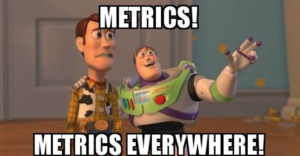In January we launched the new professional development guide that introduces a learning topic each month in 2022.
This month’s topic is ‘Meaningful Metrics’ which focuses on knowing what data to use, and when. In August, highlight the importance of supporting team members in understanding the difference between numbers, and the numbers that matter.
Data is everywhere, but is it all good data? Last year,
Forbes published an article on meaningful metrics, which provides examples and delves into some common quotes you might have heard from time to time. "You can't manage what you don't measure" and "If you can't measure it, you can't improve it" are explored more in depth in the article. In short, it is explained that just because you
can measure something doesn't mean that you should.
One example provided to justify this claim was from the early days of social media. An easy data point to measure was profile views or followers. Does this mean that high profile views implies that someone is an influencer or has far reach? Perhaps not - the author notes that there are paid services to artificially boost (or purchase) viewership. This makes measuring such data less useful.
An example of meaningful data, from the same Forbes article, is from a financial services organization. They found that there was a low number of new accounts being opened and instead of measuring new accounts being opened alone, they focused on smaller intervals throughout the entire process. This allowed the team to identify different areas needing addressed to boost the account signups. Lessons learned from this are that measuring strictly to get an end result may not be as effective as measuring the means to get to the end goal.
Veronica Head recommends that you answer three questions to determine if data is meaningful. They are:
- Can I tie this back to real performance? Does the data actually mean anything? In the article, Head compares this to running. Tracking the number of miles ran is great, but were those miles ran over the course of a day, 30 minutes, or 10 minutes? The more specific you can make the data, the more helpful it is and more easily it can impact performance.
- Does this tell a story of what's really happening? The tricky thing about data is that it can be used in many ways. Based on how the data is gathered, analyzed, and portrayed, different stories can be told. Sometimes, the same data can be used to tell more than one story simply by manipulating the graphics used when conveying the information. Always be careful in determining whether the data and means used to convey the data are representative of what is actually happening.
- Can you do something with this information? The final question that Head poses is whether there is something actionable that can come out of the data. In the article, the example given is related to a webpage receiving 7,000 views in a month. That might be a great number, but what can you do with it? If that number cannot be tied to sales, consumer demographics, or specific influencers (maybe you are paying someone to promote your brand), then those 7,000 views are only traffic to the site.


Taking a step into data can be challenging, and even more so when you add in an extra layer of meaningful data. We have tailored great content this month to help make the learning not so daunting. This month, use ENGAGE and the 2022 Learning Framework to broaden your horizons and see what data can do for you!
The new 2022 Learning Framework was developed by State team members, for State team members. Each month, we will highlight a new topic, one directly related to The Missouri Way Training Series. These trainings, along with ENGAGE conversation topics, live educational opportunities, and additional learning resources, are combined into one comprehensive package.
While participation is optional, our goal is to provide just the right amount of education so supervisors can meet their LDR goals, and all team members can meet their individual educational goals.
 Loading...
Loading...

 Taking a step into data can be challenging, and even more so when you add in an extra layer of meaningful data. We have tailored great content this month to help make the learning not so daunting. This month, use ENGAGE and the 2022 Learning Framework to broaden your horizons and see what data can do for you!
The new 2022 Learning Framework was developed by State team members, for State team members. Each month, we will highlight a new topic, one directly related to The Missouri Way Training Series. These trainings, along with ENGAGE conversation topics, live educational opportunities, and additional learning resources, are combined into one comprehensive package.
While participation is optional, our goal is to provide just the right amount of education so supervisors can meet their LDR goals, and all team members can meet their individual educational goals.
Taking a step into data can be challenging, and even more so when you add in an extra layer of meaningful data. We have tailored great content this month to help make the learning not so daunting. This month, use ENGAGE and the 2022 Learning Framework to broaden your horizons and see what data can do for you!
The new 2022 Learning Framework was developed by State team members, for State team members. Each month, we will highlight a new topic, one directly related to The Missouri Way Training Series. These trainings, along with ENGAGE conversation topics, live educational opportunities, and additional learning resources, are combined into one comprehensive package.
While participation is optional, our goal is to provide just the right amount of education so supervisors can meet their LDR goals, and all team members can meet their individual educational goals.